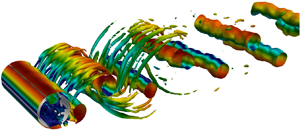Crossref Citations
This article has been cited by the following publications. This list is generated based on data provided by
Crossref.
Zhou, Shuai
Zou, Yunfeng
Hua, Xugang
and
Liu, Zhipeng
2020.
Comparison of Two-Dimensional and Three- Dimensional Responses for Vortex-Induced Vibrations of a Rectangular Prism.
Applied Sciences,
Vol. 10,
Issue. 22,
p.
7996.
Ledda, Pier Giuseppe
Boujo, E.
Camarri, S.
Gallaire, F.
and
Zampogna, G.A.
2021.
Homogenization-based design of microstructured membranes: wake flows past permeable shells.
Journal of Fluid Mechanics,
Vol. 927,
Issue. ,
Yu, Haiyang
Xu, Zhihan
Chen, Wen-Li
Li, Hui
and
Gao, Donglai
2021.
Attenuation of vortex street by suction through the structured porous surface.
Physics of Fluids,
Vol. 33,
Issue. 12,
Steiros, K.
Bempedelis, N.
and
Ding, L.
2021.
Recirculation regions in wakes with base bleed.
Physical Review Fluids,
Vol. 6,
Issue. 3,
Dong, Yangyang
Hu, Kexin
Wang, Yongbin
and
Zhang, Zijian
2021.
The steady vortex and enhanced drag effects of dandelion seeds immersed in low-Reynolds-number flow.
AIP Advances,
Vol. 11,
Issue. 8,
Ciuti, M.
Zampogna, G. A.
Gallaire, F.
Camarri, S.
and
Ledda, P. G.
2021.
On the effect of a penetrating recirculation region on the bifurcations of the flow past a permeable sphere.
Physics of Fluids,
Vol. 33,
Issue. 12,
Sun, Chenlin
Azmi, Azlin Mohd
Leontini, Justin
Zhu, Hongjun
and
Zhou, Tongming
2021.
Experimental study on the development of wake vortices behind screen cylinders.
Physics of Fluids,
Vol. 33,
Issue. 8,
Kumar, Chandan
Chatterjee, Dipankar
and
Mondal, Bittagopal
2022.
Effect of transverse magnetic field on wake dynamics and heat transfer through a porous circular cylinder.
Heat Transfer,
Vol. 51,
Issue. 8,
p.
7929.
Steiros, K.
Bempedelis, N.
and
Cicolin, M.M.
2022.
An analytical blockage correction model for high-solidity turbines.
Journal of Fluid Mechanics,
Vol. 948,
Issue. ,
Zhai, Zhenfeng
Zheng, Siming
and
Wan, Decheng
2022.
Interaction between solitary waves and a combined structure of two concentric asymmetric porous arc walls.
Physics of Fluids,
Vol. 34,
Issue. 4,
Strom, Benjamin
Polagye, Brian
and
Brunton, Steven L.
2022.
Near-wake dynamics of a vertical-axis turbine.
Journal of Fluid Mechanics,
Vol. 935,
Issue. ,
Qin, Lang
Jian, Zhen
Xu, Yeyin
and
Ma, Lifeng
2023.
On the attitude stability of flying dandelion seeds.
Physics of Fluids,
Vol. 35,
Issue. 8,
Tsao, Wen-Huai
Chen, Ying-Chuan
Kees, Christopher E.
and
Manuel, Lance
2023.
Response Mitigation of Floating Platform by Porous-Media-Tuned Liquid Dampers.
Journal of Offshore Mechanics and Arctic Engineering,
Vol. 145,
Issue. 5,
Lutsenko, Aleksandr
Kalugina, Maria
Nazarova, Dinara
and
Slobodyanyuk, Dmitriy
2023.
Features in Aerodynamic Characteristics and Flow Structures Around an Aircraft with Perforated Stabilizing Devices.
p.
1.
Caruso Lombardi, F.
Bongarzone, A.
Zampogna, G. A.
Gallaire, F.
Camarri, S.
and
Ledda, P. G.
2023.
Von Kármán vortex street past a permeable circular cylinder: Two-dimensional flow and dynamic-mode-decomposition-based secondary stability analysis.
Physical Review Fluids,
Vol. 8,
Issue. 8,
Kakroo, Karan
and
Sadat, Hamid
2024.
High-fidelity fluid–structure interaction simulations of perforated elastic vortex generators.
Physics of Fluids,
Vol. 36,
Issue. 11,
Bempedelis, Nikolaos
Gori, Filippo
Wynn, Andrew
Laizet, Sylvain
and
Magri, Luca
2024.
Data-driven optimisation of wind farm layout and wake steering with large-eddy simulations.
Wind Energy Science,
Vol. 9,
Issue. 4,
p.
869.
Hagiwara, Terumichi
Aita, Shunsuke
and
Kazama, So
2024.
Impact of Filter Unit Placement on Suspended Sediment Deposition Promotion in Rivers.
Journal of Hydraulic Engineering,
Vol. 150,
Issue. 6,
Bi, Zhen
Bao, Fubing
Zhang, Lingxin
Shao, Xueming
and
Li, Shishan
2024.
Numerical study of porous tip treatment in suppressing tip clearance vortices in cavitating flow.
Physics of Fluids,
Vol. 36,
Issue. 4,
Gayout, A.
Bourgoin, M.
and
Plihon, N.
2024.
Influence of the porosity pattern on the aerodynamics of a square-shaped fly-swatter.
Physics of Fluids,
Vol. 36,
Issue. 1,



